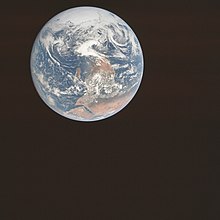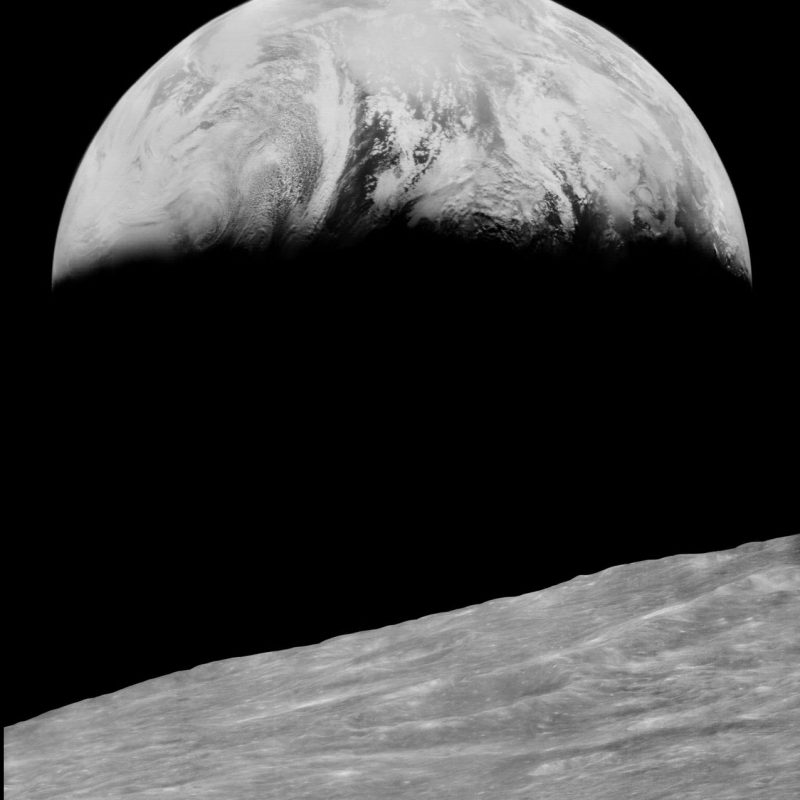“As the Sun came up I was absolutely blown away by how incredibly beautiful our planet Earth is. Absolutely breathtaking. Like someone took the most brilliant blue paint and painted a mural right in front of my eyes. I knew right then and there that I would never, ever see anything as beautiful as planet Earth again.”
Scott Kelly, Former NASA Astronaut
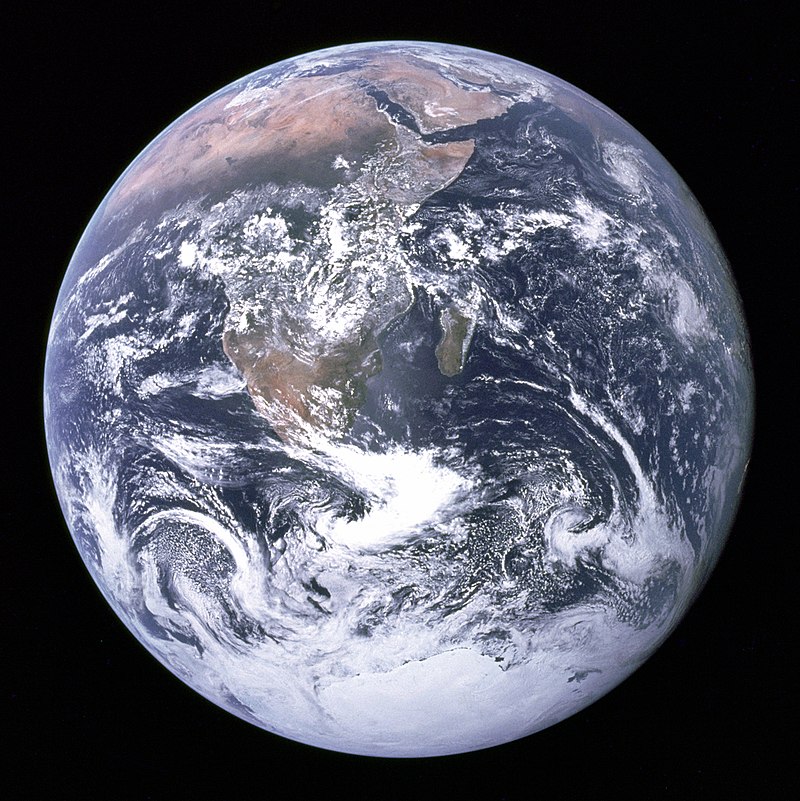
There is a common experience shared by human beings who visit that edge of space when they turn back and look upon their home planet. In that most fleeting of moments, they see the beauty and delicacy of our homeworld. It’s clearly not a view that many of us will get to experience in person, certainly not for the foreseeable future at least.
Despite that, thanks to some incredible photography and imaging techniques we too can view Earth from space and get a sense of our place in the solar system and the wider universe.
The term ‘Big Blue Marble’ as it applies to Earth refers to an image captured of our planet by the Apollo 17 astronauts in December 1972. The image — officially designated as AS17–148–22727 by NASA— was taken at 29 thousand kilometres above the Earth by the crew of the spacecraft as it headed to the Moon.
Turning their view back on our planet, the astronomers caught a stunning image of the Mediterranean Sea to Antarctica. The image shows the south hemisphere heavily shrouded by clouds and represents the first time that an Apollo craft had been able to capture the southern polar ice caps.
Perhaps the most extraordinary thing about AS17-148-22727 is that it wasn’t supposed to exist. The crew weren’t scheduled to take an image at that point in their journey.
The fact that the photo was snapped very much during a ‘stolen moment’ aboard the craft and during a mission that was tightly scheduled down to the minute, makes the fleeting beauty it presents even more striking, as too does the fact that no human since has travelled far enough away from the surface of the planet to take such an image.
Since being taken ‘the Blue Marble’ has rightfully become one of the most reproduced images in human history. Though the most famous image of Earth from a space-based vantage point and a rare example of the glimpse of a fully illuminated globe, AS17–148–22727 is just one of a cavalcade of stunning images of our planet taken over seven decades.
The very first of these images were captured in perhaps the most unusual and ironic of circumstances.
The Early days of Earth Photography: Recovering from War
“Consider again that dot [Earth]. That’s here. That’s home. That’s us. On it everyone you love, everyone you know, everyone you ever heard of, every human being who ever was, lived out their lives. The aggregate of our joy and suffering, thousands of confident religions, ideologies, and economic doctrines, every hunter and forager, every hero and coward, every creator and destroyer of civilization, every king and peasant, every young couple in love, every mother and father, hopeful child, inventor and explorer, every teacher of morals, every corrupt politician, every ‘superstar,’ every ‘supreme leader,’ every saint and sinner in the history of our species lived there – on a mote of dust suspended in a sunbeam.”
Carl Sagan, Pale Blue Dot: A Vision of the Human Future in Space
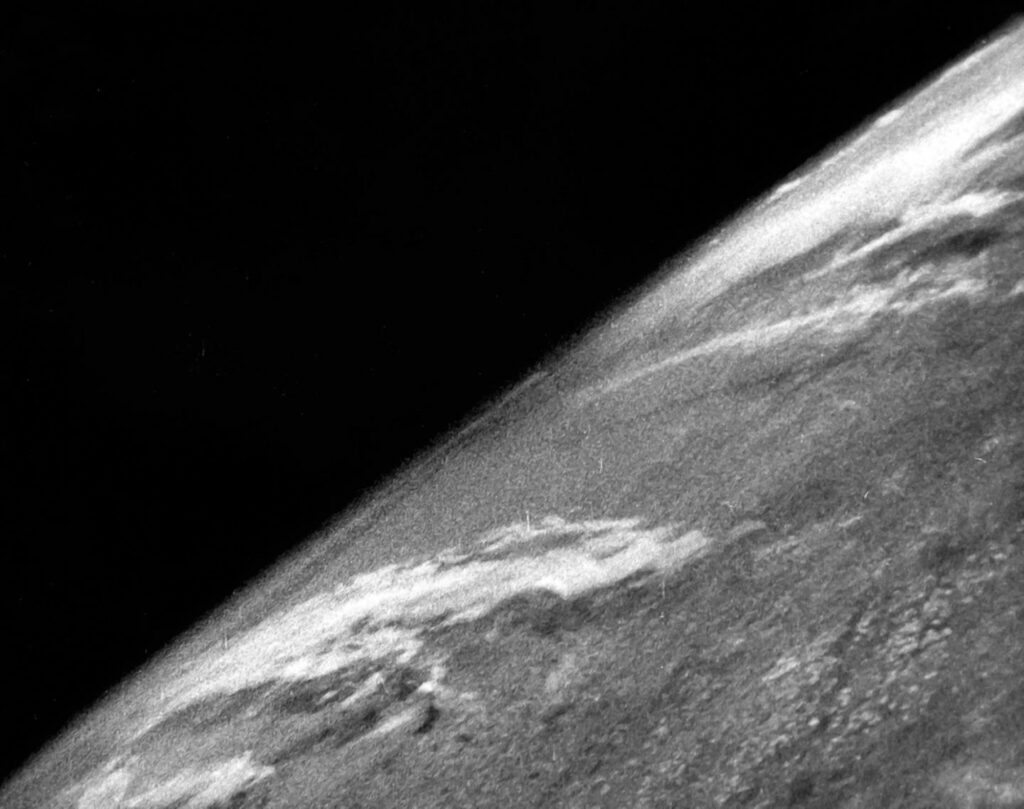
During the Second World War German V2s caused untold amounts of damage upon the cities of Europe, raining death from the skies and bringing profound fear and sorrow. It’s somewhat ironic then that the scientific marvel of the first image of Earth from space was delivered by one of these fearsome rockets.
Several V2s– Vergeltungswaffe 2, the world’s first long-range guided ballistic missiles–had been reclaimed by the United States as part of Operation Paperclip. The aim, however, was to use their incredible supersonic speed not to escape radar detection, as had been the case during the war, but to escape the confines of the atmosphere.
The rockets had their explosive payloads removed from their nosecones and replaced with scientific equipment.
On 24th October 1946, experiments with the V2s would result in a tangible benefit and a legitimate scientific breakthrough. A rocket launched from the White Sands Missile Range in New Mexico, USA, would capture an image of the Earth from an altitude of 105km. Up until this point in time, the highest an image of earth that had been taken was 22km by equipment aboard a high-altitude balloon.
The image was captured by a 35mm camera in the device’s nosecone which was set to capture a picture every 1.5 seconds. These images were then dropped back to earth in a steel canister and developed.
The V2 program and the series of experiments that it birthed would help US scientists lay the groundwork for future space exploration and was reflected by similar experiments in the Soviet Union at the time. These programs and the reclamation of German technology and the scientists behind it was responsible for launching the space race of the 1950s and 1960s. And no goal or aspiration would encompass this heated scientific battle more than the desire to put a human on the Moon.
The Earth and the Moon: Picturing a Perfect Partnership
“Orbiting Earth in the spaceship, I saw how beautiful our planet is. People, let us preserve and increase this beauty, not destroy it!”
Yuri Gagarin, the first human in space (12 April 1961)
By 1966 when the image above was captured the space race was in full swing. The USSR had launched both Sputnik 1 & 2 into orbit in October and November 1957 respectively, with the first becoming the original Earth-orbiting satellite and the second carrying a dog named Laika into space.
This would quickly be followed by US satellites Explorer 1 carrying experimental equipment that would lead to the discovery of the Van Allen radiation belt, and the world’s first communications satellite SCORE, both in 1958. In the same year, the National Aeronautics and Space Administration (NASA) would be created to replace the National Advisory Committee on Aeronautics (NACA).
Most significantly, in 1961 the Soviets would put the first human being into orbit. Cosmonaut Yuri Gagarin made a single orbit around the Earth at a speed of over 27 thousand kilometres per hour during his 108-minute stay in space.
Yet, it wasn’t the Soviets that captured the stunning image above of earth from the vicinity of the Moon’s surface. That honour belongs to the US craft Lunar Orbiter 1 (LU-A). The NASA spacecraft was the first US mission to orbit the Moon, its primary task was to photograph not the Earth but rather potential landing sites on the Moon for the upcoming Apollo missions.
Again, as was the case with Apollo 17’s ‘Blue Marble’, the image of Earth from space taken by Lu-A taken on August 28th 1966 by the onboard Eastman Kodak imaging system was completely unplanned.
In 1969 many of the Apollo missions themselves would capture stunning and evocative images of the Earth rising above the crest of the Moon’s surface–including the above image captured by Apollo 11 and the one below taken by Apollo 8. These ‘Earthrise’ photographs would become a popular expression of Earth’s relative isolation and vulnerability.

The Earth From the Surface of an Alien World
“The vast loneliness is awe-inspiring and it makes you realize just what you have back there on Earth.”
Jim Lovell, Apollo 8 Command Module Pilot, during a live broadcast from the Moon on Christmas Eve 1968.
It’s no great surprise given our advancing exploration of space that our attention has turned to the view of Earth from other alien worlds. Even though we are still capturing amazing images from that vantage point such as the one above taken by NASA’s Lunar Reconnaissance Orbiter mission in 2015, our horizons have also broadened to a view of our homeworld from the surface of more distant worlds.
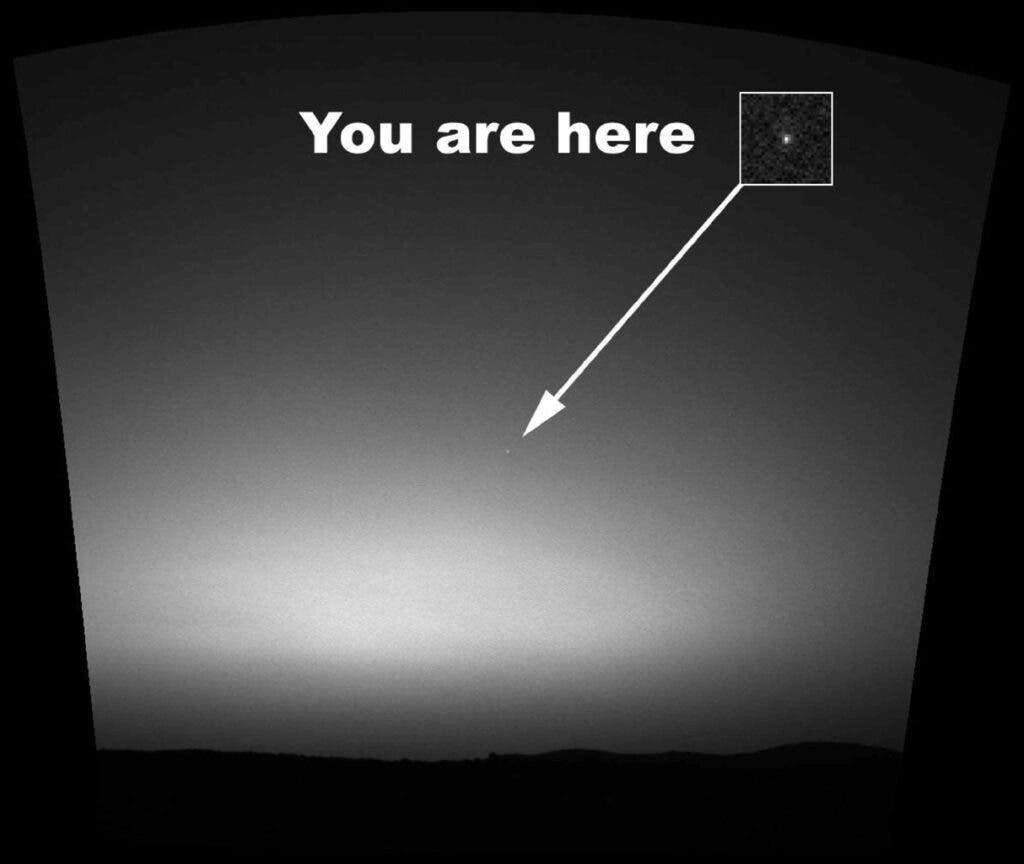
The first image of earth taken from another planet (above) was captured by the Mars Exploration Rover Spirit on the 63rd Martian day of its mission in 2004. Earth was only visible in the image–comprised from images taken by the now silent robotic rover’s four panoramic cameras–after all the colour filters were removed.
This was followed up in January 2014 by NASA’s Curiosity Rover when it captured its first glimpse of Earth from the surface of Mars.
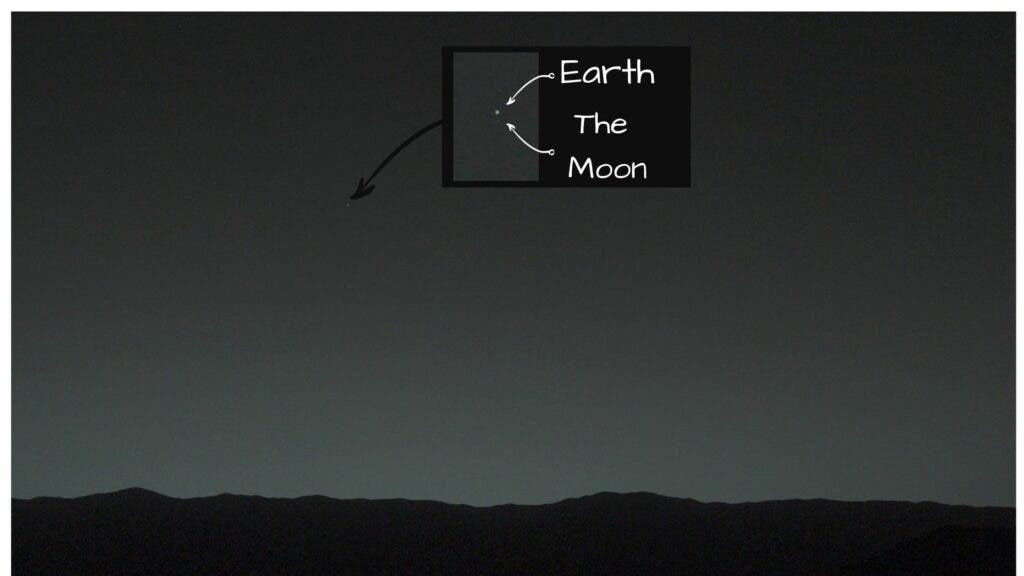
Whilst Mars Exploration Rover Spirit and the Curiosity Rover images may not be the most visually spectacular in the catalogue built during seven decades of space exploration, it stands as a testament to man’s determination to explore other worlds. a determination that nows carries us beyond the solar system.
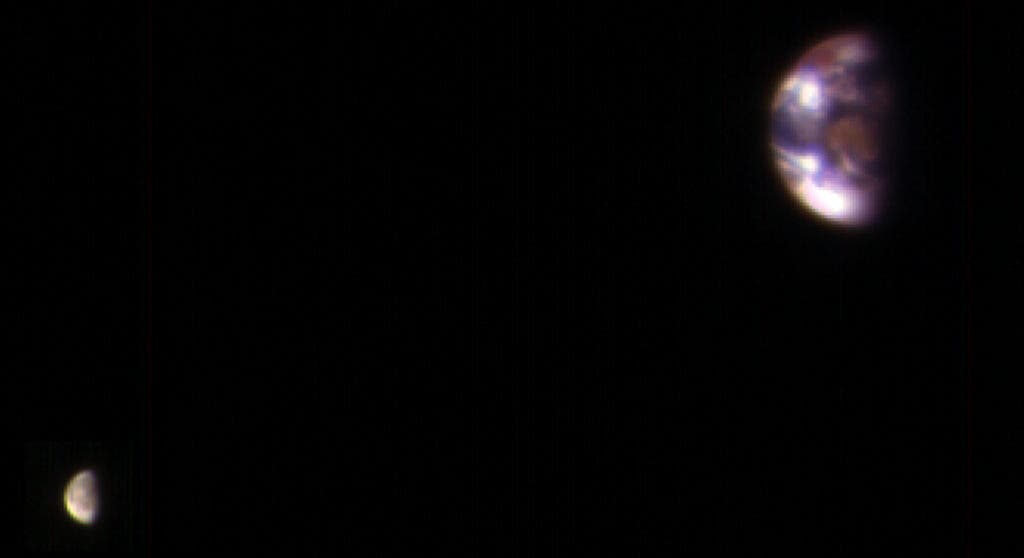
This composite image of Earth and its moon, as seen from Mars, combines the best Earth image with the best moon image from four sets of images acquired on Nov. 20, 2016, by the High Resolution Imaging Science Experiment (HiRISE) camera on NASA’s Mars Reconnaissance Orbiter. (NASA/JPL-Caltech/Univ. of Arizona)
A View on the Future
“You develop an instant global consciousness, a people orientation, an intense dissatisfaction with the state of the world, and a compulsion to do something about it. From out there on the moon, international politics look so petty. You want to grab a politician by the scruff of the neck and drag him a quarter of a million miles out and say, ‘Look at that, you son of a bitch!’ “
Edgar Mitchell, Apollo 14 astronaut and the sixth person to walk on the Moon.
As we continue to expand our view of the Universe studying cosmic bodies further and further from our own solar system, the history of space photography reminds us that it is vital we keep a view on our own planet, too. It’s a testament to our scientific progress that the hardest element about putting together a brief article about images of Earth from space that it involved sifting through thousands of incredible pictures.
Currently, NASA’s fleet of satellites consists of many craft devoted to the observation of Earth from space. Often this observation from a cosmic vantage point has the benefit of providing perspective on the damage we are doing to our world. Not only this but NASA’s continued observation of our world allows us to better understand weather patterns and mitigate potential disasters.
Humanity has never been in a better position to understand our world and its place within the wider Universe. The view of our planet from space has shown us its fragility, vulnerability, and the lengths we must go to preserve this beautiful blue marble.
“It is crystal clear from up here that everything is finite on this little blue marble in a black space, and there is no planet B.”
Alexander Gerst, European Space Agency astronaut, to world leaders live from the ISS, December 17th 2018.

